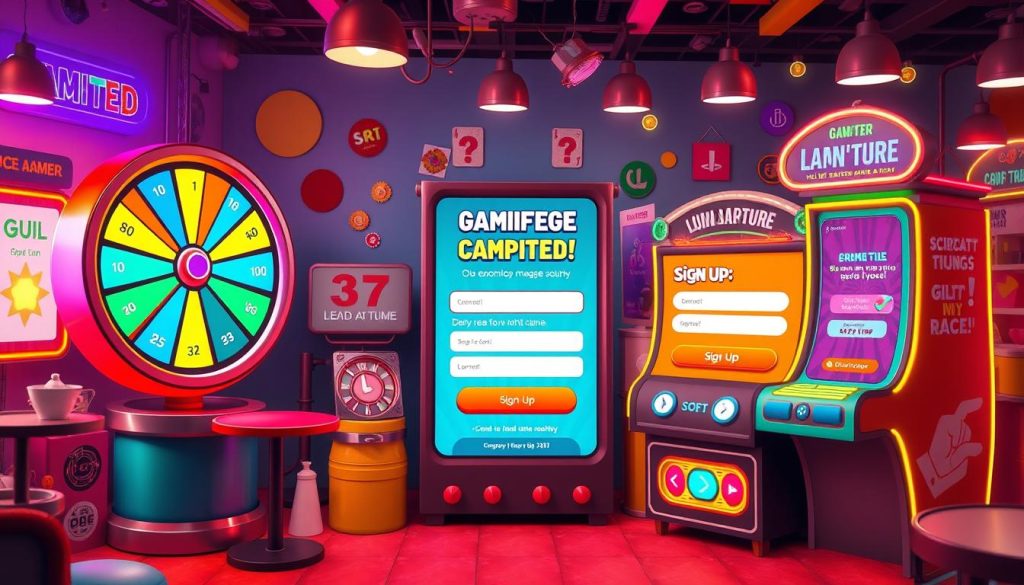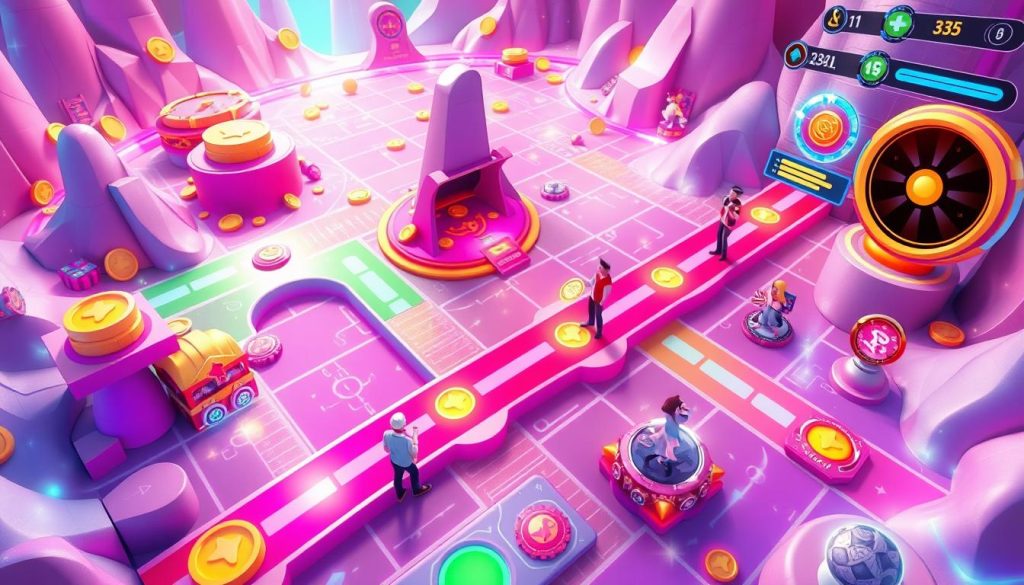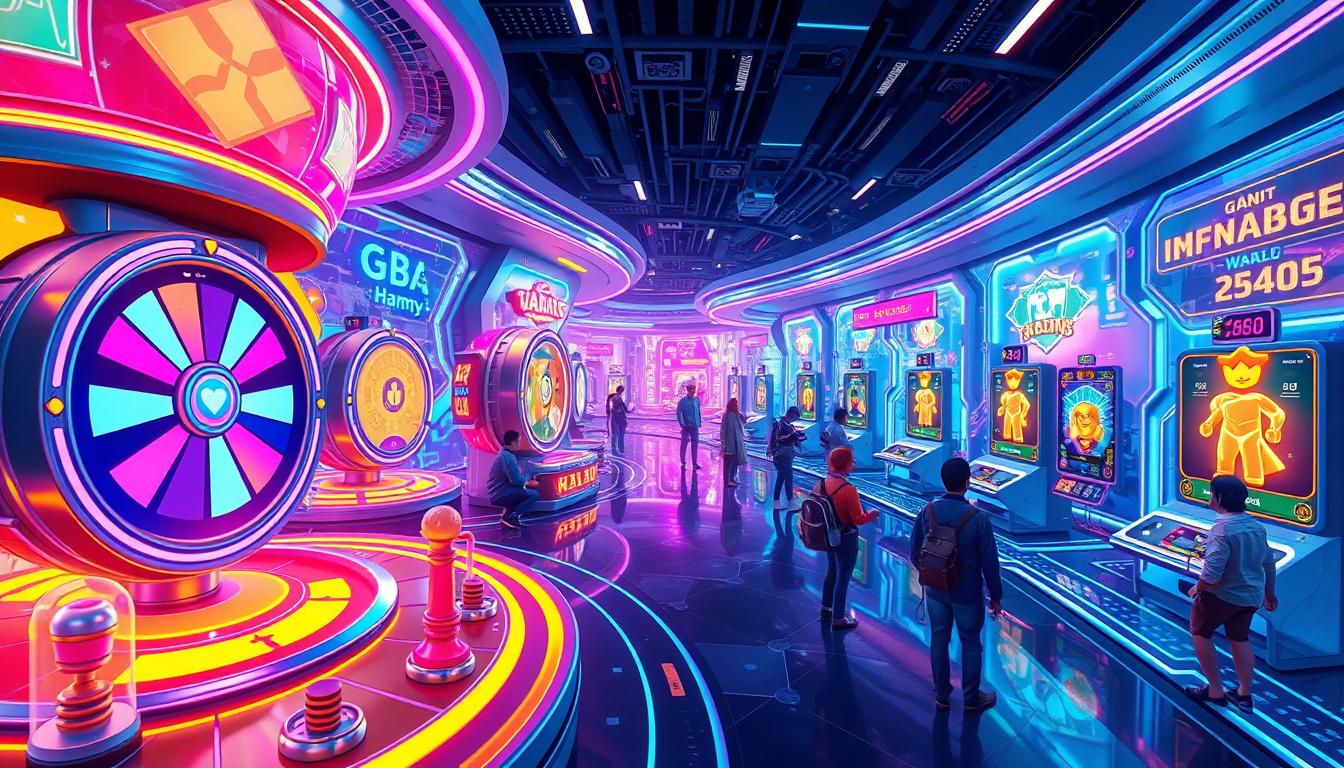In today’s digital world, marketers are always looking for new ways to grab their audience’s attention. They want to drive lead generation in meaningful ways. Gamified experiences have become a big hit. They mix game-like elements into marketing, making it fun and interactive.
This approach helps businesses connect with people on a deeper level. It taps into our love for challenges, competition, and rewards. This can make people more engaged, loyal, and ready to convert. This article will dive into how gamified experiences boost lead generation. We’ll look at the psychology, trends, and strategies that make gamification work.
Key Takeaways
- Gamification uses game-like elements to boost user engagement and lead generation.
- Interactive and rewarding experiences can grab prospects’ attention and drive conversions.
- Knowing the psychology behind engaging games is key for effective gamification.
- New trends in game-based marketing open up chances for lead nurturing and acquisition.
- It’s vital to measure gamification’s impact to improve lead generation campaigns.
Creating Gamified Experiences for Effective Lead Generation
In digital marketing, gamification is very powerful. It makes experiences fun and interactive, helping to get more leads. It taps into our love for competition, achievement, and fun. This way, brands can grab their audience’s attention and change how they get leads.
Creating these experiences means linking fun elements to lead goals. Every part of the plan must be thought out well. This way, brands can make a memorable experience that people will love.
The key to success is finding the right mix of fun and results. By doing this, businesses can use gamification for lead acquisition to get people’s attention. They can also build deeper connections and grow their business in a fun way.
| Key Elements of Effective Gamified Experiences | Benefits of Gamification for Lead Generation |
|---|---|
|
|
Understanding the Power of Gamification
The psychology behind engaging games and the latest trends in gamification are key for lead generation. They tap into our desire for challenge, accomplishment, and social interaction. This creates experiences that boost customer engagement and conversion.
The Psychology Behind Engaging Games
Games use our natural drive for intrinsic motivation. They offer goals, feedback, and a sense of progress. This releases dopamine, making us feel good and want to play more.
Games also have a social side, like leaderboards and multiplayer. These features make us feel like we belong and want to compete. This social aspect makes the game more enjoyable and increases participation.
Gamification Trends in Marketing
Gamification, using game-like elements in marketing, is becoming popular. It makes experiences more immersive, interactive, and rewarding for customers.
Some top gamification trends in marketing include:
- Interactive quizzes and assessments that give personalized tips
- Reward-based loyalty programs that encourage repeat visits
- Scavenger hunts and treasure hunts that boost website engagement
- Virtual leaderboards and badges that make us feel accomplished and competitive
By understanding the psychology of games and keeping up with gamification trends, marketers can create campaigns that grab attention. These campaigns drive real results.
“Gamification is about applying game-design thinking to non-game applications to make them more fun and engaging.”
Interactive Lead Nurturing Campaigns
In today’s fast-paced world, interactive lead nurturing campaigns are key for businesses. They help guide prospects smoothly through the sales funnel. By adding game-like elements, companies make their lead nurturing more engaging. This keeps leads interested and moving towards a sale.
Interactive quizzes, personalized content, and challenges are great ways to use gamification. They tap into our love for exploration, solving problems, and feeling accomplished. This keeps leads connected with the brand as they move through the buyer’s journey.
The success of these campaigns depends on providing value and gathering important data. By tailoring the experience to each lead, businesses can make their path to conversion more effective. This makes the experience more personalized and valuable.
Using game mechanics like leaderboards and rewards adds a fun element. It motivates leads to stay engaged and invested in what the brand offers. This approach not only improves the user experience but also helps businesses learn and improve their marketing.
As people want more personalized and engaging marketing, interactive lead nurturing campaigns are crucial. By using gamification, businesses can make their lead generation more dynamic and effective. This leads to a better path to conversion.
Game-Based Marketing Tactics
In the world of digital marketing, game-based tactics are becoming key for getting leads. By gamifying content and incorporating game mechanics, companies can grab their audience’s attention. This method makes the user experience better and boosts lead capture chances.
Gamifying Content for Lead Capture
One top game-based marketing tactic is gamifying content for lead capture. This means creating fun landing pages, lead magnets, or quizzes. These elements, like points and rewards, make the process more fun and rewarding.
Incorporating Game Mechanics
- Points and Scoring Systems: Giving points for actions, like filling out forms, makes people feel accomplished and keeps them coming back.
- Leaderboards and Competitions: Showing leaderboards or running contests sparks a friendly competition. This pushes leads to act to get to the top.
- Rewards and Incentives: Offering discounts or exclusive content for certain actions is a great way to get leads to participate and convert.
By gamifying content for lead capture and incorporating game mechanics, companies can use our natural love for challenge and achievement. This leads to better engagement and more conversions.
Engaging Prospects Through Gaming
Traditional lead generation methods often fail to grab the attention of today’s prospects. But, using gaming can change that. It creates fun experiences that engage people and lead to more leads.
Gaming is all about challenge, reward, and competition. By adding game-like elements to lead generation, marketers can make it fun and informative. This keeps prospects interested and wanting to learn more.
- Gamified experiences create emotional connections with prospects. They remember and engage with fun, interactive content.
- Game-based lead nurturing campaigns guide prospects through the sales funnel. They get valuable info while staying involved.
- Gamified content, like quizzes or simulations, is great for capturing leads. Prospects share their info for a rewarding experience.
Using gaming in lead generation is not just a trend. It’s a powerful tool for businesses. By understanding game psychology and marketing trends, companies can engage prospects better. This leads to impressive lead generation results.
“Games are the most elevated form of investigation.” – Albert Einstein
Gamified Lead Capture Strategies
In the fast-paced world of lead generation, smart marketers have found the power of gamified lead capture strategies. They add game-like elements to their lead forms and landing pages. This makes the experience more fun and engaging for their audience.
Playful Lead Conversion Techniques
After capturing leads, businesses can use playful techniques to guide them towards buying. Interactive quizzes, challenges, and rewards can be part of the lead nurturing process. This keeps prospects interested and motivated to move closer to making a purchase.
| Gamified Lead Capture Strategies | Playful Lead Conversion Techniques |
|---|---|
|
|
By combining gamified lead capture strategies and playful lead conversion techniques, businesses can create an unforgettable experience. This experience not only grabs the audience’s attention but also boosts lead generation and conversion.

“Gamification is not just a trend, but a powerful tool that can transform the way businesses approach lead generation and conversion.”
Using game-like elements in lead capture and conversion can change how companies connect with and nurture prospects. It leads to better engagement, higher conversion rates, and stronger customer relationships.
Lead Generation Through Gamified Content
Brands are finding new ways to get leads through gamified content. This method uses our love for play and interaction. It helps businesses grab their audience’s attention and get more leads.
Fun-Filled Lead Acquisition Approaches
Gamified content makes lead generation fun and memorable. It includes interactive videos and virtual worlds. These methods not only draw in leads but also build strong connections and loyalty.
A top e-commerce brand used a mobile game to get more leads. Players explored a colorful world, finding discounts and offers. This game not only brought in new leads but also boosted sales and repeat customers.
| Gamified Content Type | Key Attributes | Lead Generation Impact |
|---|---|---|
| Interactive Videos | Engaging storylines, branching narratives, and strategic decision-making | Increased lead capture, higher engagement, and improved lead qualification |
| Virtual Experiences | Immersive digital worlds, personalized journeys, and rewarding achievements | Enhanced brand awareness, lead nurturing, and customer loyalty |
| Mobile Games | Addictive gameplay, embedded lead capture mechanisms, and shareable content | Rapid lead generation, data collection, and viral marketing potential |
The secret to great lead generation with gamified content is making it fun and strategic. Brands should add lead forms and offers into the game. This way, they can turn their lead efforts into a success.
Game Mechanics in Lead Generation
Smart marketers know how game mechanics can grab and keep their audience’s attention. They use these interactive tools to make lead generation more effective. Game mechanics, like points and leaderboards, can push users to take actions like filling out forms or sharing content.
Points and rewards are a big help in getting more leads. When users get points for actions, they feel a sense of achievement. This makes them want to do more, like climb the leaderboard or earn badges.
- Points and Rewards: Leverage points, leaderboards, and badges to incentivize lead capture and nurturing activities.
- Challenges and Quests: Design compelling challenges or quests that guide users through a lead generation journey, building interest and excitement along the way.
- Progress Tracking: Allow users to visualize their progress, creating a sense of momentum and achievement that can drive further engagement and conversion.
Using game mechanics in lead generation taps into our natural drive for success and fun. It makes the experience better and boosts results like more leads and higher conversion rates.
“Gamification is not just about points and badges. It’s about using game design elements to create a more engaging, immersive, and motivating experience for your audience.” – Jane Doe, Marketing Strategist

Measuring the Impact of Gamification
It’s key for marketers to check how well gamification works in getting leads. By looking at important numbers, they can see what’s working and what’s not. This helps them make their strategies better.
Important numbers to watch include how many leads are captured, how engaged people are, and how many become customers. Also, seeing how much money is made from gamification is crucial. These numbers help understand if gamification is really helping.
To really know how gamification is doing, businesses should use data and test things out. Data insights can show the best ways to get and keep leads. By always improving their gamification, businesses can get more leads and grow.
Key Metrics for Measuring Gamification Impact
- Lead Capture Rates
- Engagement Levels
- Conversion Rates
- Return on Investment (ROI)
| Metric | Definition | Importance |
|---|---|---|
| Lead Capture Rates | The percentage of visitors who submit their information through a gamified lead capture mechanism. | Measures the effectiveness of gamified lead capture tactics in converting website visitors into leads. |
| Engagement Levels | The level of user interaction and participation in a gamified experience, such as time spent, points earned, or challenges completed. | Indicates the level of user engagement and the ability of the gamification strategy to captivate and retain the audience. |
| Conversion Rates | The percentage of leads that are converted into sales or other desired actions through the gamified lead nurturing process. | Evaluates the effectiveness of gamified lead nurturing tactics in driving tangible business outcomes. |
| Return on Investment (ROI) | The ratio of the revenue generated or cost savings achieved through gamification compared to the investment in implementing the gamified strategy. | Determines the overall financial impact and the viability of the gamification approach for the business. |
By watching these important numbers, marketers can learn a lot about their gamification efforts. They can make smart choices to improve their lead generation strategies. This way, they can get the best results from their efforts.
Conclusion
The power of gamified experiences is huge for lead generation. By adding game-like elements to marketing, businesses can grab their audience’s attention. This leads to better lead conversion rates.
Interactive campaigns and game-based tactics are changing lead generation. Marketers who understand games can create fun, engaging experiences. This keeps prospects interested and wanting to learn more.
As marketing keeps changing, gamification’s role will grow. Businesses that use these new methods will succeed. They’ll attract and convert prospects in ways old methods can’t.
FAQ
What is the role of gamified experiences in lead generation?
Gamified experiences make marketing campaigns more engaging. They use game-like elements to capture and convert prospects. This approach taps into psychological principles to boost lead generation.
How can companies create engaging, interactive gamified experiences for lead generation?
To create effective gamified experiences, companies need a solid plan. They should set clear goals and design immersive gameplay. Aligning gamification with lead generation strategies is key to success.
What are the psychological mechanisms that make games and gamified experiences so engaging?
Games and gamified experiences engage us by tapping into our motivations and goals. They use feedback loops and social interaction to keep us interested. Marketers can use these principles to make their campaigns more compelling.
How can gamification be integrated into lead nurturing campaigns?
Gamified elements like quizzes and challenges can be added to lead nurturing workflows. This keeps leads engaged and guides them through the sales funnel. It helps increase conversion rates.
What are some game-based marketing tactics that can be used for lead generation?
Making content like landing pages and lead magnets more engaging through gamification can boost lead capture. Using game mechanics like points and rewards can also encourage desired behaviors.
How can companies effectively engage prospects through gaming?
Creating immersive and entertaining game-like interactions can captivate audiences. It builds emotional connections and drives meaningful interactions. This leads to more leads and conversions.
What are some gamified lead capture strategies and playful lead conversion techniques?
Adding game-like elements to lead capture forms and landing pages can increase participation. Playful techniques that incorporate gamification can also nurture prospects towards conversion.
How can companies leverage gamified content to drive lead generation?
Interactive content like videos and mobile games can attract and engage leads in a fun way. Effective gamified content should have key attributes for successful lead acquisition.
What game mechanics can be applied to lead generation campaigns?
Mechanics like points and leaderboards can be used to motivate users. They encourage desired behaviors like lead capture and conversion.
How can companies measure the impact of gamification on their lead generation efforts?
Tracking KPIs like lead capture rates and conversion rates is crucial. Data analytics and testing help optimize gamification tactics for better results.


